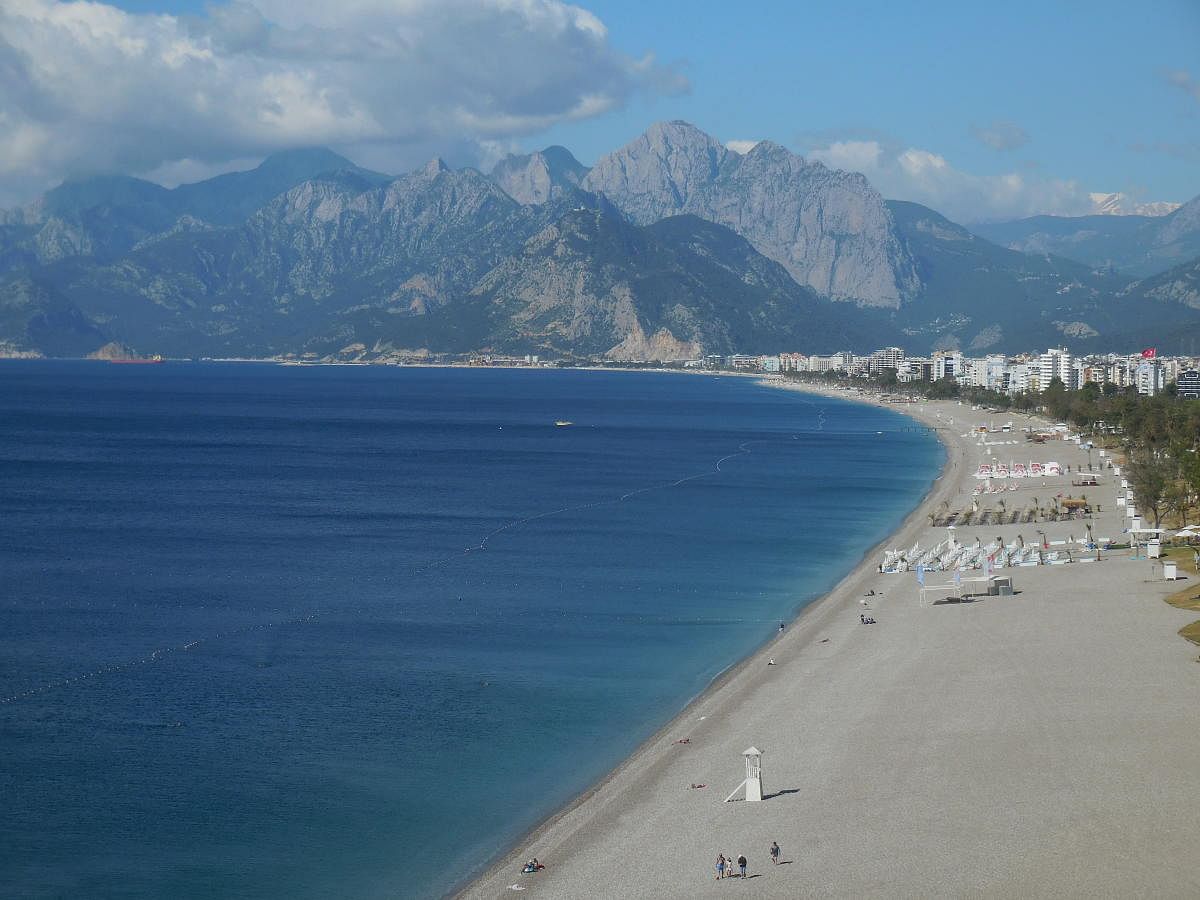
I began my Turkish sojourn in Antalya, the gateway to Turkey’s South Mediterranean region. Famously called ‘Pamphylia’ in ancient history, it is now known as the Turquoise Coast for its blue waters. Antalya awed me with its rich cultural mélange, archaeological wonders, landmarks, and beautiful bays and harbours. There are more than 20 waterfalls around Antalya, and Duden Falls and Manavgat are particularly stunning. For golfing enthusiasts, Belek is the golfing capital of Turkey. It has hosted players like Tiger Woods. Antalya is also a favoured destination of Bollywood filmmakers.
Antalya holds the world record for having the highest number of ‘Blue Flag’-certified beaches across the world. Just across Antalya Museum is Konyaalti, a shingles beach against the backdrop of the Taurus Mountains and it is one of the myriad Blue Flag-certified beaches in Antalya.
Kaleici, the Old Quarter, the historic city centre in Antalya is a great place to base yourself as you explore the city and surrounding area. As we rambled around the winding streets, alleyways, and the cobblestoned roads in Kaleici, we passed by picturesque Ottoman-styled villas and houses with wooden bay windows framed by geraniums and incarnations. Kaleici is an utterly delightful maze of steep narrow curving down to the ancient harbour.
When the Roman emperor Hadrian visited the city in 130 AD, he entered the city via a Roman triumphal arch (now known as Hadrian’s Gate), built in his honour. Today, the renovated arch marks the entrance to Kaleiçi — literally ‘within the castle’. It is flanked by the remains of the walls which once encircled the town. Today, the vestiges of the structures dating from the Romans, Byzantines, Seljuks and Ottomans give one a sense of the scale of their settlements and their importance.
Antalians are fiercely proud of the old city of Kaleici which is punctuated with other attractions like the imposingly magnificent Yivli Minare, the 18th-century clock tower, the captivating ancient Roman ruins of Kesik Minare, and the Hidrilik Kulesi fortress that overlooks the Mediterranean harbour. A stroll downhill took us to Antalya’s Roman Harbour, built in the second century BC, and now a glitzy marina home to yachts and an array of excursions boats, particularly pirate-themed. Locals and holidaymakers frequent the old harbour front, a popular eating and watering hole. But we opted to hop on to a large wooden yacht and sailed on the turquoise waters surrounding Antalya. In the distance, we saw the crumbling remains of the giant stone walls that once encircled the town and fortified its inhabitants.
Time travel
As with all ancient towns, the ruins are the major draw in Antalya, with most of them being well preserved and restored. On the second day, before we headed out of the city to discover the ancient sites of Perge and Aspendos, we visited Antalya Museum, a comprehensive collection of artefacts dating from the
Stone and Bronze age to Byzantium. In the Hall of Gods, we had a peek at the glorious and evocative statues of 15 Olympian gods. The sarcophagi on display here are equally interesting.
As we sauntered around Perge scouting for the stadium, we found its crumbling ruins. We discovered some vestiges of some of Turkey’s finest civilisations in Perge, one of the most important towns of ancient Pamphylia. We stumbled upon other interesting archaeological sites like the rectangular-planned agora, necropolis, high towers, monumental fountains, column-lined streets, and Greek and Roman gates. St. Paul visited Perge and preached the first sermon here. Wandering among the scattered ruins, we got a sense of the splendours of a once-great civilisation.
From one archaeological site, we flitted to another equally impressive one. We found the remains of ancient basilicas and Roman aquaducts. Built during Aspendos’s golden age in the reign of Emperor Marcus Aurelius, the antique open-air theatre at Aspendos is considered the most complete Roman theatre of the ancient world. It hosts an annual international opera and ballet festival which draws the leading opera and ballet artistes from all over the world.
There’s more to Antalian street food than the kebab. We tried gozleme, savoury pancakes filled with potatoes and cheese. The Turkish love their coffee and tea as much their dondurma (ice cream.) When in Antalya, don’t miss the sticky sweet Turkish delights and baklava. Try the meatballs and haricot bean salad, which are dishes strongly associated with Antalya.